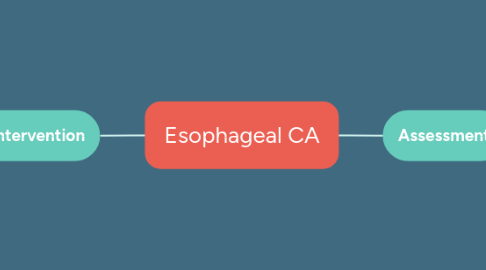
1. Intervention
1.1. Post-oral surgery or radiation
1.1.1. Semi or high Fowler's position
1.1.1.1. Facilitate breathing and respiratory care
1.1.2. Prevent post-op PNA
1.1.2.1. Deep breathe and cough
1.1.2.2. Turn Q2H
1.1.2.3. Chest physiotherapy
1.1.3. Prevent aspiration
1.1.3.1. Assess LOC, gag reflex, and ability to swallow
1.1.3.2. Have suction equipment ready
1.1.3.3. Thicken liquids as prescribed
1.1.4. Pain management
1.1.4.1. Opioids
1.1.4.2. NSAIDs
1.1.4.2.1. Reduce inflammation
1.1.5. Incision care
1.1.5.1. Risk for infection
1.1.5.2. Oral care Q4H
1.1.6. Nutrition
1.1.6.1. Oral
1.1.6.1.1. Once oral feeding starts...
1.1.6.2. Enteral
1.1.6.2.1. Tube feedings
1.1.6.3. Parenteral
1.1.6.3.1. Total parenteral nutrition (TPN)
1.1.6.3.2. Peripheral parenteral nutrition (PPN)
1.1.6.3.3. Monitor for complications
1.1.7. Temporary or permanent trach
1.1.7.1. Trach care
1.1.7.1.1. Q Shift and PRN
1.1.7.2. Routine oral care
1.1.7.2.1. Soft-bristle toothbrush
1.1.7.2.2. Chemobrushes with warm saline/sodium bicarbonate
1.1.7.2.3. NO commercial mouthwash
1.1.7.3. Method of communication
1.1.7.3.1. Pt may not be able to speak initially
1.1.7.3.2. Total laryngectomy
1.1.8. NG tube placement post surgery
1.1.8.1. Secure placement to prevent dislodgment
1.1.8.2. Never irrigate or reposition without orders
1.1.8.3. Oral care Q2 to 4 hours
1.1.8.4. Keep HOB semi Fowler's
1.1.8.4.1. Prevent aspiration
1.2. Patient education
1.2.1. Avoid
1.2.1.1. Tobacco
1.2.1.2. ETOH
1.2.1.3. Processed meat
1.2.1.4. Foods and drinks high in temperature
1.2.2. GERD
1.2.2.1. Discuss with HCP to treat and control GERD
1.2.3. Weight monitoring
1.2.3.1. Notify HCP if excessive weight loss
1.2.3.1.1. Imbalanced nutrition
2. Assessment
2.1. Risk factors
2.1.1. Tobacco
2.1.2. ETOH
2.1.3. GERD
2.1.3.1. Barrett's esophagus
2.1.4. High temperature food and beverages
2.1.5. Men 2x > women
2.1.6. Blacks and Asians (far East: Japan, China)
2.2. S/S
2.2.1. Persistent and progressive dysphagia
2.2.1.1. Solid food --> semi-solid --> liquid
2.2.1.2. Feelings of food sticking in the throat
2.2.1.3. Regurgitation
2.2.1.4. Complications
2.2.1.4.1. Aspiration
2.2.1.4.2. Imbalanced nutrition
2.2.2. Odynophagia
2.2.2.1. Painful swallowing
2.2.2.1.1. Imbalanced nutrition
2.2.3. Chronic cough with increased secretions
2.2.3.1. May be caused by esophagotracheal fistula
2.2.4. Hoarseness
2.2.4.1. 2/2 compression to the vocal cord
2.2.5. A/N/V
2.2.5.1. Weight loss
2.2.5.1.1. Imbalanced nutrition
2.3. Labs and diagnostics
2.3.1. Esophagoduodenoscopy (EGD) with biospy
2.4. Post-surgical (esophagectomy) assessment
2.4.1. Airway and breathing!
2.4.2. Assess LOC, gag reflex, and ability to swallow before feeding
2.4.3. Assess leakage of fluids or saliva from suture lines
2.4.3.1. Anastomotic leak
2.4.3.1.1. S/S
2.4.3.1.2. Stop all PO intake
2.4.4. NG tube
2.4.4.1. Purpose: stomach decompression
2.4.4.2. Check placement Q4H
2.4.4.3. Check patency and drainage
2.4.4.3.1. Bloody initially
2.4.4.3.2. Yellowish green after 8 to 12 hours
2.4.4.3.3. Persistent bloody secretions
2.5. Complications
2.5.1. Aspiration
2.5.1.1. S/S
2.5.1.1.1. Choking
2.5.1.1.2. Coughing after PO intake
2.5.1.2. Complications
2.5.1.2.1. Airway obstruction
2.5.1.2.2. PNA
2.5.2. Post-op PNA
2.5.2.1. Encourage incentive spirometer
2.5.3. Post-op esophageal reflux
